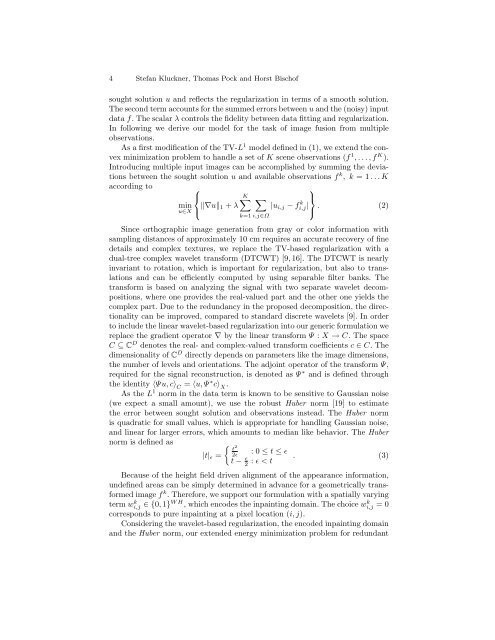Exploiting Redundancy for Aerial Image Fusion using Convex ...
Exploiting Redundancy for Aerial Image Fusion using Convex ...
Exploiting Redundancy for Aerial Image Fusion using Convex ...
Create successful ePaper yourself
Turn your PDF publications into a flip-book with our unique Google optimized e-Paper software.
4 Stefan Kluckner, Thomas Pock and Horst Bischof<br />
sought solution u and reflects the regularization in terms of a smooth solution.<br />
The second term accounts <strong>for</strong> the summed errors between u and the (noisy) input<br />
data f. The scalar λ controls the fidelity between data fitting and regularization.<br />
In following we derive our model <strong>for</strong> the task of image fusion from multiple<br />
observations.<br />
As a first modification of the TV-L 1 model defined in (1), we extend the convex<br />
minimization problem to handle a set of K scene observations (f 1 , . . . , f K ).<br />
Introducing multiple input images can be accomplished by summing the deviations<br />
between the sought solution u and available observations f k , k = 1 . . . K<br />
according to<br />
⎧<br />
⎫<br />
⎨<br />
K∑<br />
min<br />
u∈X ⎩ ‖∇u‖ ∑<br />
⎬<br />
1 + λ |u i,j − fi,j|<br />
k ⎭ . (2)<br />
k=1 i,j∈Ω<br />
Since orthographic image generation from gray or color in<strong>for</strong>mation with<br />
sampling distances of approximately 10 cm requires an accurate recovery of fine<br />
details and complex textures, we replace the TV-based regularization with a<br />
dual-tree complex wavelet trans<strong>for</strong>m (DTCWT) [9, 16]. The DTCWT is nearly<br />
invariant to rotation, which is important <strong>for</strong> regularization, but also to translations<br />
and can be efficiently computed by <strong>using</strong> separable filter banks. The<br />
trans<strong>for</strong>m is based on analyzing the signal with two separate wavelet decompositions,<br />
where one provides the real-valued part and the other one yields the<br />
complex part. Due to the redundancy in the proposed decomposition, the directionality<br />
can be improved, compared to standard discrete wavelets [9]. In order<br />
to include the linear wavelet-based regularization into our generic <strong>for</strong>mulation we<br />
replace the gradient operator ∇ by the linear trans<strong>for</strong>m Ψ : X → C. The space<br />
C ⊆ C D denotes the real- and complex-valued trans<strong>for</strong>m coefficients c ∈ C. The<br />
dimensionality of C D directly depends on parameters like the image dimensions,<br />
the number of levels and orientations. The adjoint operator of the trans<strong>for</strong>m Ψ,<br />
required <strong>for</strong> the signal reconstruction, is denoted as Ψ ∗ and is defined through<br />
the identity 〈Ψu, c〉 C<br />
= 〈u, Ψ ∗ c〉 X<br />
.<br />
As the L 1 norm in the data term is known to be sensitive to Gaussian noise<br />
(we expect a small amount), we use the robust Huber norm [19] to estimate<br />
the error between sought solution and observations instead. The Huber norm<br />
is quadratic <strong>for</strong> small values, which is appropriate <strong>for</strong> handling Gaussian noise,<br />
and linear <strong>for</strong> larger errors, which amounts to median like behavior. The Huber<br />
norm is defined as<br />
{ t<br />
2<br />
|t| ɛ = 2ɛ<br />
: 0 ≤ t ≤ ɛ<br />
t − ɛ 2 : ɛ < t . (3)<br />
Because of the height field driven alignment of the appearance in<strong>for</strong>mation,<br />
undefined areas can be simply determined in advance <strong>for</strong> a geometrically trans<strong>for</strong>med<br />
image f k . There<strong>for</strong>e, we support our <strong>for</strong>mulation with a spatially varying<br />
term w k i,j ∈ {0, 1}W H , which encodes the inpainting domain. The choice w k i,j = 0<br />
corresponds to pure inpainting at a pixel location (i, j).<br />
Considering the wavelet-based regularization, the encoded inpainting domain<br />
and the Huber norm, our extended energy minimization problem <strong>for</strong> redundant















